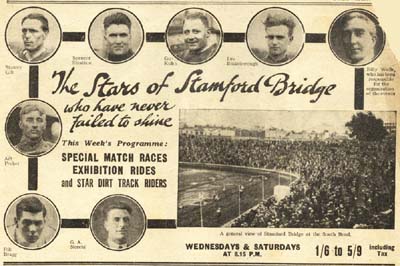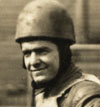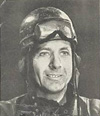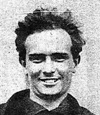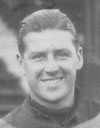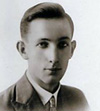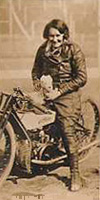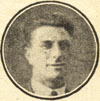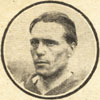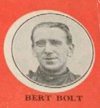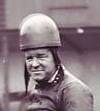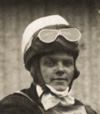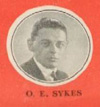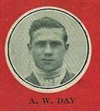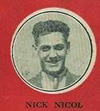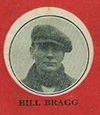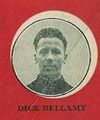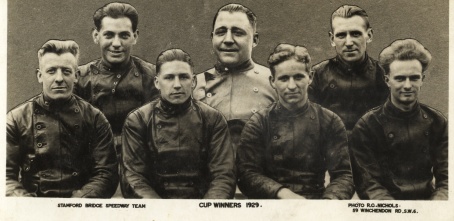|
Page updated
16-Apr-2011
|
In the final of the senior race R Frogley beat G Kuhn by half a length, thanks to a spectacular skid on the banking immediately preceding the finish. But the highlight of the evening was Sprouts Elder, the American, giving exhibition rides with Stewie St. George. Four days later, Stamford Bridge echoed to the roar of speedway bikes again. This time Sprouts Elder took part in the racing. In this first full season of speedway racing in Britain there was no league structure, tracks operating a system of individual races.
Popular as Elder was with the Stamford Bridge faithful, it was another American who was to prove to be their idol. At his first appearance Art Pechar was to make an attempt on the four lap record, but it looked like his first ride at Stamford Bridge might be his last as he crashed badly into the safety fence coming out of the first turn. But Art slowly and painfully rose to his feat, remounted his machine and flew off from the start. This time his ride was faultless and he broke the track record. From that moment on the Stamford Bridge crowd took him to their hearts and Art Pechar could do no wrong.
Art Pechar's last 1928 appearance at Stamford Bridge came on 22 August when he was presented with a silver cup. On that same night, Stamford Bridge took on Crystal Palace in an inter-track match. In the first race Gus Kuhn defeated Triss Sharp, while in the second Les Blakebrough beat Bill Delaney. With Sprouts Elder also heading back home at the end of August, the season continued mainly with British riders, such as Stamford Bridge regulars Roger Frogley, Gus Kuhn, Les Blakebrough and Fred Ralph. Over the close season, a Southern Promoters' Association was formed. Together with the ACU, they tried to regularise the rules for competitions. The most important reform was the institution of league speedway. Twelve teams, including Stamford Bridge, entered the Southern League. As star riders were excluded, Stamford Bridge's team consisted of Gus Kuhn (captain), Bill Bragg, Wal Phillips, Les Blakebrough, Fred Ralph, Colin Ford, Bert Bolt, Alan Day and L O Bellamy. The team colours were blue and white and their nickname was the Pensioners.
Skipper Gus Kuhn was the star of the side, scoring 188 points from 80 rides, with able backing from Wal Phillips and Les Blakebrough. So strong were these three, that Stamford Bridge reeled off ten straight victories in their first ten matches and were only defeated three times in the entire season, winning the championship by two points from Southampton. A bitter controversy sprang up, however, over the manner of Stamford Bridge's triumph. At all other tracks, races were got underway by rolling starts. The races were started by the four riders coming up to the line together at about 15 mph as the flag fell. At Stamford Bridge, however, this was considered to be too dangerous as the track was very narrow and it was felt that a rolling start would lead to too many first bend pile-ups. Consequently, Stamford Bridge employed a system of push starts, where the bikes were pushed off by the track staff as the flag fell. It was rumoured that the staff, while pushing off their own team promptly, were inclined to hold back the opposing riders. This was, of course, denied by the Stamford Bridge management, who pointed to the fact that the Pensioners had won seven out of ten matches away from home as well. It is, however, probably true that the team had a distinct advantage at their own track as it was so narrow and therefore different to what other riders would have been used to.
Stamford Bridge were fortunate in securing the services of the Overseas Star champion, Frank Arthur, who loved the narrow confines of the Stamford Bridge track and was appointed captain of the 1930 league campaign. Gus Kuhn, Les Blakebrough, Wal Phillips, Bert Bolt and Colin Ford continued with the team and were joined by newcomers Nick Nicol, Ernie Mayne and Arthur Warwick. A supporters club was formed and for two shillings you got a badge plus discounted tickets, as well as club dances and socials. The Pensioners were not quite so successful this year and had to be content with third place behind Wembley and Southampton, the latter even managing the seemingly impossible task of beating Stamford Bridge at home. The London Cup, run on a home and away knockout basis, was instituted in 1930 and Stamford Bridge got through to the final, having beaten West Ham and Harringay on the way. Unfortunately, they met a very strong Wembley side in the final and were beaten 105-86 on aggregate.
More changes came in 1931 when, for the first time, a national competition was introduced. Stamford Bridge reached the final, but once again Wembley proved superior, winning convincingly by 120 points to 69. In the Southern League, Stamford Bridge went one better than in the previous year, finishing as runners-up to Wembley. The team had stayed much the same as in 1930, with the addition of Charlie Blacklock and Dick Wise.
1932 was a bitter sweet year for Stamford Bridge. It was the year when the Northern and Southern leagues were amalgamated to form the National League. As a precursor to this, the National Speedway Association Trophy was held, also along league lines. With a team consisting of Frank Arthur, Wal Phillips, Gus Kuhn, Jack Chapman, Arthur Warwick, Bill Stanley, Dick Wise, Dicky Smythe and Ted Bravery, Stamford Bridge romped home to victory. In the National League itself, Stamford Bridge suffered a setback, and with Dicky Smythe, Dick Wise and Ted Bravery all injured for part of the season, they could only manage fourth place. With a successful team and attendances up, it seemed that Stamford Bridge was assured of a long run in the sport, but then came the bombshell. The stadium owners announced that they no longer wished to have speedway and wanted to convert it to a greyhound track. And so, at the end of the 1932 season, speedway disappeared from Stamford Bridge, never to return. Edited from 'Speedway in London' by Norman Jacobs ISBN 0752422219
|
||||||||||||||||||||||||||||||||||||||||||||||||||||||||||||||||||||||||||||||||||||||||||||||||||||||


